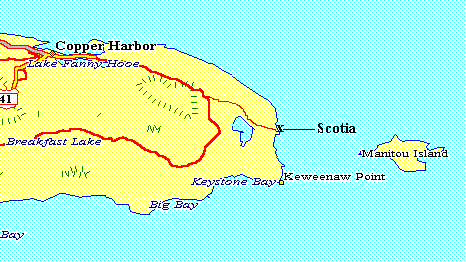
Type: Iron Steamer Length: 231 ft., 1502 gt. Depth: 15 -25 ft. Location: High Rock Bay, Keweenaw Point LORAN: 31697.8/46710.6 LAT/LON: 47.25.87'/87.42.29'

Initially, the Scotia was in no danger, as she had a favorable wind, but a change in direction caused the pounding waves to break her amidships. Contemporary accounts relate "the gangway decks being apart five inches, the bottom all gone and the port sid e badly broken." The stern soon sank into ten feet of water, while the bow remained on the rocks. In this condition, she was declared a total loss and sold to the salvagers.
The Scotia had been built at Buffalo, New York in 1873. One of four identical iron steamers (the others were the Java, Russia and Cuba), she was a fast ship, powered by twin screw 600 horsepower engines. The Scotia had just been purchased by a new owner 10 days before her loss.
The Scotia remained on the rocks for two years until the salvage company, employing a diver, cut off her upper works and retrieved her boilers and engines. An additional 150 tons of scrap metal were taken as well. In the 1960s, divers brought up one of her propellers which is now on display at Fort Wilkins State Park in Copper Harbor.
Today, the remains of the Scotia are entirely broken up and scattered. They lie 150 ft off High Rock Point and can be accessed from shore. Visibility is about 40 ft. at this site and water temperature is in the high 30s to low 40s. The lake is often ro ugh at the point, and care should be taken when shore diving in heavy seas. Access is difficult, as there are no developed roads in this area. A 7 mile trail off the end of US 41 leads to this sight, but there are many forks, and a local guide is a good idea. A four wheel drive vehicle with significant clearance is a must for these rocky trails. Once at High Rock Bay, locate the old University of Michigan rocket launch platform. The remains lie 150 ft. directly off shore from the platform. Divers who visit the Scotia can also visit the remains of the steamers City of Bangor and Altadoc which lie just offshore about three miles west of the Scotia.

References: Keweenaw Shipwrecks by Fred Stonehouse, Julius F. Wolff Jr.'s Lake Superior Shipwrecks, Divers Guide to Michigan by Steve Harrington, Shipwreck! by David Swayze.